When people hear the word Sikhism, the first image to come mind is of a beard and a turban – almost always a Sikh man. While Sikh men are overbearingly the symbol of Sikhism, that was never the aim of the tradition. Sikhism is actually considered the first religion to provide equal status to men and women from its inception. Sikh women have a long history of fighting patriarchy, enacting radical change, and taking up leadership roles. Patriarchy has long let these inspirational women hide in the background of the larger Sikh narrative.
Here are five Sikh women in history you should know about:
1. Mata Khivi (1506-1582)
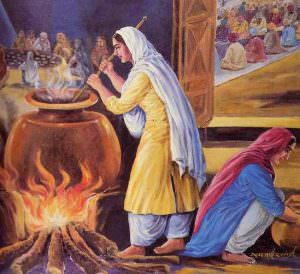
Mata Khivi making Langar | Image via Gurbani.co
Mata Khivi is best known as the person who expanded the Sikh tradition of langar, the free kitchen, to what it is today. Born to a wealthy family, she was the wife of the 2nd Guru of Sikhism Guru Angad Dev. They both came to Sikhism around the same time and through different people. And once Guru Angad Dev was given the Guruship she took an important role in spreading Sikhism’s teachings to women. Specifically, ensuring them their position as equals.
It was then that she continued the first Guru, Guru Nanak’s tradition of giving meals to everyone. Under her administration, that the langar began to be known as Mata Khivi ji da Langar (Mata Khivi Ji’s langar) because of the care she put into each of these meals and she is instrumental in institutionalizing this practice. She was also active in making the Sewa (service) tradition what it is now. Her legacy remains today as Gurudwaras in India serve millions of people daily.
We now assign this language of “free” food to langar, because of our capitalist understanding of who is entitled to food, but the concept Mata Khivi created was transgressing free based this idea that the food belongs to God, thus it is for everyone, and nobody has ownership of the food, to begin with. It’s also important to note that her role of supervising the langar was a role outside of her home, one that was not common for women to have in 16th century Punjab.
2. Mata Sundari (born circa 1670s-1747)
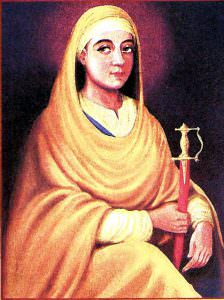
Mata Sundari | Image via Manvir Singh via Flickr
Born around the 1660s, Mata Sundari was the wife of Guru Gobind Singh. She singlehandedly managed the Sikh religion after the passing of her husband, the last living Guru. It is said that under her rule, Sikhism was able to sustain itself and flourish for 40 years.
She also collected the works of her late husband for publishing and made sure all Gurudwaras were under proper management. She issued her own seal and issued orders to the Khalsa army, which was now trying to re-establish control after the loss of Guru Gobind Singh. Sikh warriors had also broken into two factions, and Mata Sundari with her own strategic and spiritual knowledge invested in the help of Bhai Mani Singh to bring them together, she was successful.
Unfortunately, most mainstream Sikh history doesn’t accord this leadership role to Mata Sundari, and only keeps her in the role of mothering her fearless sons.
3. Mai Bhago (1666-unknown)
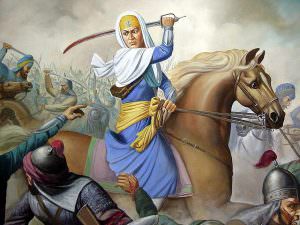
Mai Bhago | Image via Hindustan Times
Mai Bhago was the first woman to fight on the battlefield in Punjab. She was from the village of Jhabal Kalan and grew up with the Sikh faith. While the Khalsa army was passing through Muktsar, she met some 40 Sikhs who wanted to leave the battle because they were severely outnumbered. She put on the battle outfit that men wore, a radical symbol of what she felt empowered to do, and led them back into battle. She had learned gatka, the traditional Sikh martial arts, from her father as a child.
The Khalsa army wasn’t similar to the armies of today but was a part of Guru Gobind Singh’s army against Mughal tyranny. The battle of Muktsar on December 29, 1705, was between 250 Khalsa warriors and 20,000 Mughal warriors. She was the only surviving Sikh in that battle. Due to the sheer impact of that fight which left 4,000 Mughals dead, it was a pivotal moment in the ending of the Khalsa/Mughal conflict for the duration of Guru Gobind Singh’s life.
Afterward, she became one of Guru Gobind Singh’s bodyguards.
4. Sophia Duleep Singh (1876-1948)
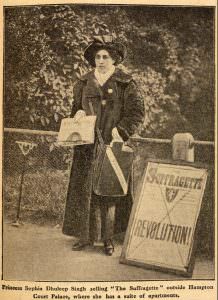
Sophia Duleep Singh Selling Suffragette Newspaper, Credit: Wikimedia Commons
Sophia was born in 1876, and was an important suffragette in the British suffragette movement. The daughter of Maharaja Duleep Singh of the Sikh Empire. Duleep Singh was exiled to England after the abdication of his Kingdom to the British. It was there that he had Sophia. She was raised in an aristocratic British household after the death of her father, who passed when she was only 17, taken care of by Queen Victoria herself.
After visiting India both in 1903 and 1907 she became against the British Empire. She met freedom fighters, Gopal Krishna Gokhale and Lala Lajpat Rai. And after her return, she joined the Women’s Social and Political Union where she began her work in the suffragette movement. She used her title of “Princess” to her advantage and in 1910, with a group of other activists asked to see the Prime Minister and discussed women’s advancement. She was called to court two times after and when was asked to pay fine for petty things, such as not having a dog license, she said she won’t pay the fees if she has no right to vote.
During WWI she also joined the Red Cross to tend to Sikh troops, and they could not believe that their nurse was the granddaughter of Maharaja Ranjit Singh.
It is known that Singh struggled with her Sikh identity that she wasn’t able to deeply understand due to her family’s forced removal from Punjab. It is known that she embraced some Sikh teaching after her visits to India, and asked to be cremated according to the Sikh rites.
5. Gulab Kaur (circa 1890-1931)
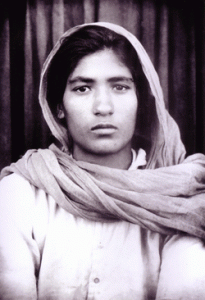
Gulab Kaur | Photo by Amarjeet Chandan
Gulab Kaur was a freedom fighter with the Ghadar Party. She and her husband moved from British India to the Philippines on their way to the U.S. where most of the Ghadar Party was based. She made the decision to leave her husband in the Philippines to devote herself more deeply to the cause. The party itself was made up of Indian-Sikh diaspora who were trying to abdicate India from British rule, and they were based in California.
She was in charge of the printing and distribution of party literature, and was also known to give speeches on boats to Indian passengers. When her husband returned to India to partake in the struggle there, she chose to go back. On her entrance with other Ghadaritiesm she was imprisoned and tortured at Lahore’s Shahi Quila. She passed away in 1931. There isn’t a lot of scholarship on Gulab Kaur, although there is a Punjabi language book titled Gadhar di dhee- Gulab Kaur Gadar’s Daughter-Gulab Kaur.
Also read: What Does Sikhism Say About Homosexuality?
This list is by no means comprehensive. Please suggest us other Sikh women in history that we might have missed in this article in the comments section below.
About the author(s)
Jasveen is currently a student at the New School studying poetry, race and ethnicity, and gender studies. You can find her either in New Delhi or New York. She's interested in gender justice, religion, diverse art, and class reform. Her twitter is: @jasveenflies
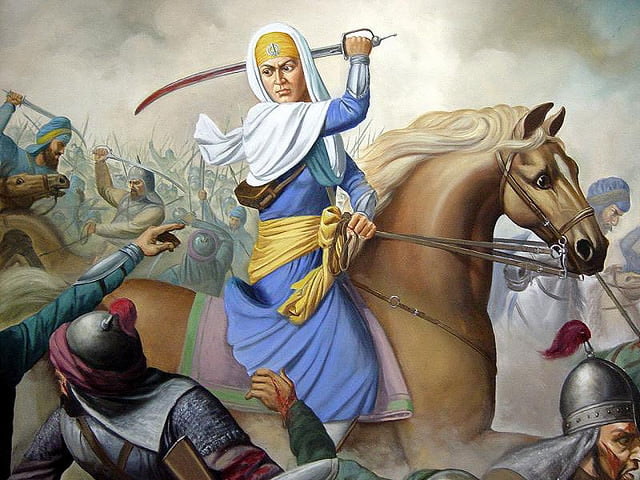




Surprising that I did not find mention of Sada kaur
Hey, this article was really helpful for my project, moreover i have found this really amazing website for the trending stuff in India and to my surprise it covers all thats happening in India and the trends in India.